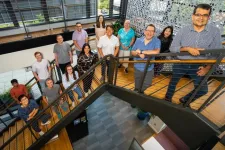Shedding light on superconducting disorder
2024-09-16
(Press-News.org)
The importance of disorder in physics is only matched by the difficulty to study it. For example, the remarkable properties of high-temperature superconductors are greatly affected by variations in the chemical composition of the solid. Techniques that enable measurements of such disorder and its impact on the electronic properties, such as scanning tunnelling microscopy, work only at very low temperatures, and are blind to these physics near the transition temperature. Now, a team of researchers of the Max Planck Institute for the Structure and Dynamics of Matter (MPSD) in Germany and Brookhaven National Laboratory in the United States has demonstrated a new way to study disorder in superconductors using terahertz pulses of light. Adapting methods used in nuclear magnetic resonance to terahertz spectroscopy, the team was able to follow the evolution of disorder in the transport properties up to the superconducting transition temperature for the first time. The work by the Cavalleri group has appeared in Nature Physics.
Superconductivity, a quantum phenomenon that allows for electrical current to flow without resistance, is among the most important phenomena in condensed matter physics due to its transformative technological impact. Many materials that become superconducting at so-called ‘high temperatures’ (around -170°C), such as the well-known cuprate superconductors, derive their remarkable properties from chemical doping, which introduces disorder. However, the exact impact of this chemical variation on their superconducting properties remains unclear.
In superconductors, and condensed matter systems more generally, disorder is typically studied with experiments featuring precise spatial resolution, such as by using extremely sharp metallic tips. However, the sensitivity of these experiments restricts their application to liquid helium temperatures, far below the superconducting transition, thereby preventing the study of many fundamental questions related to the transition itself.
Drawing inspiration from ‘multi-dimensional spectroscopy’ techniques initially developed for nuclear magnetic resonance, and later adapted to visible and ultraviolet optical frequencies by chemists studying molecular and biological systems, MPSD researchers extended this class of techniques to the terahertz frequency range, where collective modes of solids resonate. This technique involves sequentially exciting a material of interest with multiple intense terahertz pulses, typically in a collinear geometry in which the pulses travel along the same direction. To investigate the cuprate superconductor La1.83Sr0.17CuO4 — an opaque material that transmits minimal light — the team extended the conventional scheme by implementing two-dimensional terahertz spectroscopy (2DTS) in a non-collinear geometry for the first time, allowing the researchers to isolate specific terahertz nonlinearities by their emission direction.
With this angle-resolved 2DTS technique, the researchers observed that superconducting transport in the cuprate was revived after excitation by the terahertz pulses, a phenomenon they termed ‘Josephson echoes’. Surprisingly, these Josephson echoes revealed that the disorder in superconducting transport was significantly lower than the corresponding disorder observed in the superconducting gap measured by spatially resolved techniques, such as scanning microscopy experiments. Moreover, the versatility of the angle-resolved 2DTS technique enabled the team to measure disorder near the superconducting transition temperature for the first time, finding that it remained stable up to a relatively warm 70% of the transition temperature.
In addition to a deeper understanding of the enigmatic properties of cuprate superconductors, the researchers emphasize that these first experiments open the door to many exciting future directions. Besides applying angle-resolved 2DTS to other superconductors and quantum materials more broadly, the ultrafast nature of 2DTS makes it applicable to transient states of matter too short-lived for conventional probes of disorder.
END
[Attachments] See images for this press release:

ELSE PRESS RELEASES FROM THIS DATE:
2024-09-16
FRANKFURT. In January 2024, 16 Frankfurt-based research institutions joined forces to set up the “Frankfurt Alliance”, made up of Goethe University Frankfurt and several non-university research institutions. With the aim of visualizing at an event held in the heart of the Main metropolis both the strength and the diversity of research conducted in the science city of Frankfurt and the larger Rhine-Main region, including its importance for society, the alliance invites you to the first “Science Festival”, held
on Saturday, September 28, from 10 a.m. to 7 p.m.
at Roßmarkt
in ...
2024-09-16
The Alliance for Clinical Trials in Oncology today announced final results will be presented at ESMO 2024 from CABINET (A021602), a phase III trial evaluating cabozantinib compared with placebo in two cohorts of patients with previously treated neuroendocrine tumors: one cohort of patients with advanced pancreatic neuroendocrine tumors (pNET) and a second cohort of patients with advanced extra-pancreatic NET (epNET). The study met the primary objective for each cohort, demonstrating that cabozantinib provided dramatic improvements in median ...
2024-09-16
To build upon a quarter-century of world-renowned research in zoonotic viral diseases, X.J. Meng has been rewarded with a prestigious National Institutes of Health (NIH) Method to Extend Research in Time (MERIT) Award – the first awarded to Virginia Tech.
“This is a huge honor and privilege,” said Meng, University Distinguished Professor of Molecular Virology in the Virginia-Maryland College of Veterinary Medicine and a member of the National Academy of Sciences. “It is really gratifying to know ...
2024-09-16
By Benjamin Boettner
(BOSTON) — Researchers at the Wyss Institute for Biologically Inspired Engineering at Harvard Universityreceived a contract for up to $12M from the Defense Advanced Research Projects Agency (DARPA)’s new SHIELD program. The SHIELD (Synthetic Hemo-technologies to Locate and Disinfect) program aims to develop a prophylactic treatment that can be broadly administered to trauma victims in combat casualty care scenarios to rapidly clear multiple bloodborne bacterial and fungal pathogens, limit morbidity and mortality, and protect recipients for up to seven days.
Blood ...
2024-09-16
The deadly H5N1 avian influenza virus, which has killed millions of birds worldwide since 2021 – and in rare cases can be transmitted to humans – may be spread through the food-stealing behaviour of some seabirds.
A study published today in the journal Conservation Letters highlights food theft – also known as ‘kleptoparasitism’, where some seabird species like frigatebirds and skuas force other birds to regurgitate their prey – as a possible transmission path for the spread of avian flu.
Led by scientists from UNSW Sydney’s ...
2024-09-16
SAN ANTONIO — September 16, 2024 —Researchers from Southwest Research Institute (SwRI) and The University of Texas at San Antonio (UTSA) are creating innovative military helmet pads designed to prevent traumatic brain injury (TBI). The project, led by SwRI’s Dr. Daniel Portillo and UTSA’s Dr. Morteza Seidi, is supported by a $125,000 grant from the Connecting through Research Partnerships (Connect) program.
Traumatic brain injury can affect human performance and quality of life. It is ...
2024-09-16
Indianapolis – Patients with low-risk cancers undergoing active surveillance face a favorable long-term prognosis. David Haggstrom, M.D., MAS, makes the case that it’s time for the medical field to help manage the anxiety caused by waiting.
Dr. Haggstrom, a physician-researcher with Regenstrief Institute, the Veterans Administration Medical Center in Indianapolis and the Indiana University School of Medicine, is lead author of a Viewpoint article, published in JAMA (Journal of the American Medical ...
2024-09-16
The Kinsey Institute at Indiana University, in partnership with leading sexual wellbeing company the Lovehoney Group and its Womanizer brand, has released early data from new nationally representative surveys exploring menopause knowledge, symptom management, medical care engagement, and health disparities among Americans.
Phase 1 surveyed of 1,500 American adults aged 18-88, to assess overall public knowledge and understanding of menopause. Phase 2 surveyed 1,500 women aged 40-65, to better understand women’s experiences with menopause. ...
2024-09-16
DALLAS, September 16, 2024 — As the new school year begins, the American Heart Association is supporting student health and well-being by awarding financial grants to nearly 80 elementary, middle and high schools nationwide. These grants, part of the Association’s commitment to improve cardiovascular health for all people everywhere, will allow local schools in communities across the country to invest in vital resources such as new fitness equipment, water filling stations and health education ...
2024-09-16
BALTIMORE, September 16, 2024— A new study from Kennedy Krieger Institute shows that the majority of children diagnosed with long COVID are likely to experience orthostatic intolerance (OI), a condition that causes the body to struggle with regulating blood pressure and heart rate when standing up. As a result, children often feel dizzy, lightheaded, fatigued and may experience “brain fog” or cognitive difficulties.
Orthostatic intolerance includes disorders such as postural orthostatic tachycardia syndrome (POTS) and orthostatic hypotension. Among the patients studied, dizziness (67%), fatigue (25%), ...
LAST 30 PRESS RELEASES:
[Press-News.org] Shedding light on superconducting disorder



